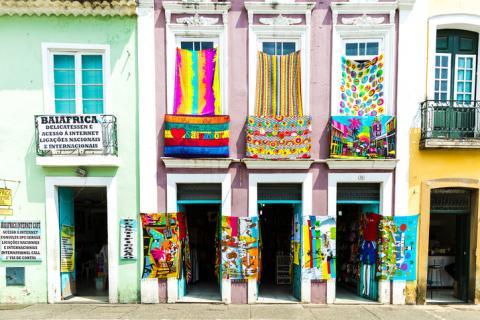Top 10 universities in Latin America 2024
| Latin America Rank 2024 | Latin America Rank 2023 | University | Country | World University Rank 2025 |
| 1 | 2 | University of São Paulo | Brazil | =199 |
| 2 | 3 | University of Campinas | Brazil | 351–400 |
| 3 | 11 | Federal University of Rio de Janeiro | Brazil | 601–800 |
| 4 | 1 | Pontificia Universidad Católica de Chile | Chile | 501–600 |
| 5 | 10 | Universidade Estadual Paulista (Unesp) | Brazil | 801–1000 |
| 6 | 8 | Pontifical Catholic University of Rio de Janeiro (PUC-Rio) | Brazil | 601–800 |
| =7 | 4 | Tecnológico de Monterrey | Mexico | 601–800 |
| =7 | 6 | Universidade Federal do Rio Grande do Sul | Brazil | 601–800 |
| 9 | 9 | University of Chile | Chile | 1001–1200 |
| 10 | 12 | Universidade Federal de Santa Catarina | Brazil | 1001–1200 |
If you are looking to study at one of the top universities in Latin America, heading to Brazil might be your best bet, based on the results of the 2024 Times Higher Education Latin America University Rankings. The country has an impressive 69 universities in the league table.
The 2024 ranking includes 214 institutions in 16 countries.
The University of São Paulo has claimed the first place position this year, knocking Pontificia Universidad Católica de Chile off the top spot, ending the Chilean institution’s five-year run at number one.
Colombia is another good choice for students looking to study in Latin America, with 38 universities in the ranking. Other countries with a strong presence include Chile (32 universities) and Mexico (26).
The Latin America University Rankings use the same methodology as THE’s World University Rankings, but some of the indicators have been recalibrated to reflect the profile of higher education in Latin America and the Caribbean. The full methodology can be found here.
1. University of São Paulo, Brazil
The University of São Paulo is Brazil’s oldest and largest university. Four of its 11 campuses are in São Paulo, while the remaining campuses are in the cities of Bauru, Lorena, Piracicaba, Pirassununga, Ribeirão Preto and São Carlos, which has two.
The university has many recreational activities and facilities, including museums and galleries, two theatres, a cinema, a TV channel and an orchestra.
Five hospitals are affiliated with the institution, including the University of São Paulo Medical School Public Hospital, which is a major training hospital for the university’s School of Medicine.
2. University of Campinas, Brazil
The University of Campinas, or Unicamp, is based in the city of Campinas in the São Paulo region of Brazil.
Although it is one of Brazil’s youngest universities (it was founded in 1964), Unicamp has established itself as a primary medical and scientific research centre. The institution is responsible for about 15 per cent of academic research conducted in Brazil.
International undergraduates will need to sit an exam before acceptance. The exam requires prospective students to have a good grasp of Portuguese.
Neither domestic nor international students pay tuition fees, as is the case in all state-run universities in Brazil.
The university offers 66 undergraduate programmes and 152 postgraduate programmes across four main areas: exact sciences, human sciences, biological sciences, and technologies.
3. Federal University of Rio de Janeiro, Brazil
The Federal University of Rio de Janeiro, sometimes known as the "University of Brazil" and commonly abbreviated to UFRJ, is one of the largest and best-known universities in Brazil. It was founded by the Brazilian state in 1792.
The university operates across a number of campuses and facilities throughout Rio de Janeiro, but is primarily focused on Ilha do Fundão, an artificial island off the western shore of Rio’s famous Guanabara Bay. This campus, known as College City, offers a huge range of services and activities for students, including a free shuttle bus services for crossing Rio de Janeiro, various restaurants and cafes, a sports centre, as well as accommodation for students.
4. Pontificia Universidad Católica de Chile, Chile
The Pontificia Universidad Católica de Chile is one of six private Catholic universities in Chile and one of two pontifical universities in the country.
Founded in 1888, the university originally taught law, mathematics, legal sciences and physical sciences. However, the course catalogue has since expanded to include subjects such as theology, philosophy, commerce and technology.
Four of the university’s campuses are located in Santiago, Chile’s capital and its cultural, political and financial centre, home to the headquarters of many multinational companies.
The fifth campus is in Villarrica, next to the city’s lake.
5. Universidade Estadual Paulista (Unesp), Brazil
Universidade Estadual Paulista (Unesp) was created in 1976 through the merger of a range of institutions in São Paulo.
Unesp has 34 centres in 24 cities, including one in the capital and one on the coast of São Paulo, more specifically in the city of São Vicente.
Unesp offers 136 undergraduate courses and 150 postgraduate programmes in a range of subjects including health, engineering, communications, humanities, arts, social sciences and theoretical sciences.
The university’s various campuses are also home to a diverse range of contemporary artworks, historical artefacts, farms, museums and a zoo, as well as hospitals and libraries.
The 50 top universities in Latin America 2024
Click each institution to view its full World University Rankings 2024 results

Comments